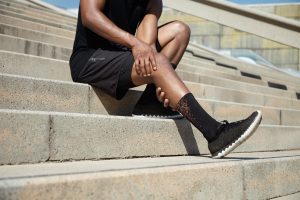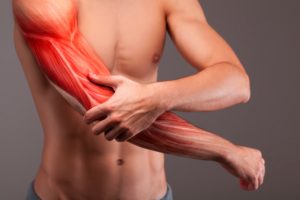What is muscle pain?
All people are at risk of muscle pain which can occur in any of the muscles in the body. Muscle aches and pains are common and can involve more than one muscle.
Muscle pain can be localised to one muscle group or diffuse, involving multiple muscle groups. Depending upon the cause, muscle pain can range from mild to severe and debilitating.
Muscle pain is the hallmark symptom of some chronic conditions (like fibromyalgia) and several conditions can be associated with generalised aches and pain (such as influenza) that are perceived to be muscle pain. Related symptoms that can occur with muscle pain are tenderness, swelling, redness or fever.
Common causes of muscle pain
Often, people who experience muscle aches can easily pinpoint the cause. This is because most instances of myalgia result from too much stress, tension or physical activity. Some common causes include:
- muscle tension in one or more areas of the body
- overusing the muscle during physical activity
- injuring the muscle while engaging in physically demanding work or exercise.
Changes to your exercise routine can lead to tiny injuries in your muscle fibres and connective tissue. About a day later, you’ll start to feel sore.
How long does muscle pain last?
Your muscles may get sore right away. This is known as acute soreness. You may feel them ache or tighten up about 12 hours after you exercise. In some cases, the discomfort may peak 48 to 72 hours afterwards. This is called delayed-onset muscle soreness (also known as DOMS). During this time, your muscles repair and strengthen themselves. Muscle pain can improve quickly or last several days.
Treating muscle pain
To help relieve muscle soreness, try:
- gentle stretching
- muscle massage
- rest
- ice to help reduce inflammation
- heat to help increase blood flow to your muscles
- over-the-counter pain medication, such as a nonsteroidal anti-inflammatory drugs (NSAID) like ibuprofen.
Sore muscles are normal. However, be careful that you don’t do serious injury to your muscles. If you think you have a strain or a sprain, try the RICER approach.
The RICER approach is recommended within the first two to three days after a sprain, strain and soft tissue injury:
R – Rest and avoid further physical activity
I – Ice the affected area for up to 20 minutes every 2 hours
C – Compress and wrap the area with a firm elastic bandage, and only loosen if you have sensations of numbness
E – Elevate and rest the injured limb, such as on a chair or a cushion
R – Refer to a doctor for a professional medical opinion to improve your chances of a full recovery.
When to see a doctor about muscle pain
Remember to always consult with a medical professional if you are experiencing:
- Muscle soreness which lasts for more than a week
- Pain is unbearable and prevents you from moving
- Pain gets worse with exercise
- Pain causes dizziness or trouble breathing
- You notice redness, swelling, or warmth in the sore muscles
- The RICER treatment doesn’t work.
Prevention of muscle pain
If your muscle pain is caused by tension or physical activity, here are a few tips to lower your risk of developing muscle pain in the future:
Warm up
Studies show that warming up your muscles before exercise may be better than stretching them. It wakes up your muscles by increasing blood flow to them. To warm up, do light versions of certain exercises. These include slow jogging or biking, jumping rope, or lifting light weights.
Rest
If you aren’t getting enough quality sleep, then you’re putting your body at a recovery disadvantage from the beginning. It is also a good idea to wait about 48 hours before working the same muscle groups. For example, running uses the muscles in your lower body. Give those muscles two days to rest and heal before you exercise them again if you are experiencing muscle soreness. If you don’t rest, you can cause muscle fatigue or damage, rather than muscle growth and strength.
Drink water
Staying hydrated is vital for recovery and growth of muscle tissue. Additionally, water will help with the removal of toxins that build up in the body. Without water, your body will struggle to perform at its highest level. You may have muscle cramps, fatigue, dizziness or more serious symptoms.
Use proper technique
Doing exercises the correct way helps protect you from muscle strain or injury. If you belong to a gym or health club, ask a trainer or instructor for help. They can show you the proper way to lift weights and use machines and equipment.
Cool down
It’s important to stretch after you work out. Your muscles are relaxed and more flexible when they are warm. Stretching also circulates blood away from your muscles and back to your heart to aid in recovery.
Reminder
Stay within your limits. You may be tempted to push yourself but remember to progress slowly with exercise. If you try to increase to a higher level too soon, you may injure yourself.
Your sore muscles might be due to something other than tension and physical activity. In this case, your doctor will best be able to advise you on how to fully resolve your muscle pain. The first priority will be to treat the primary condition.






